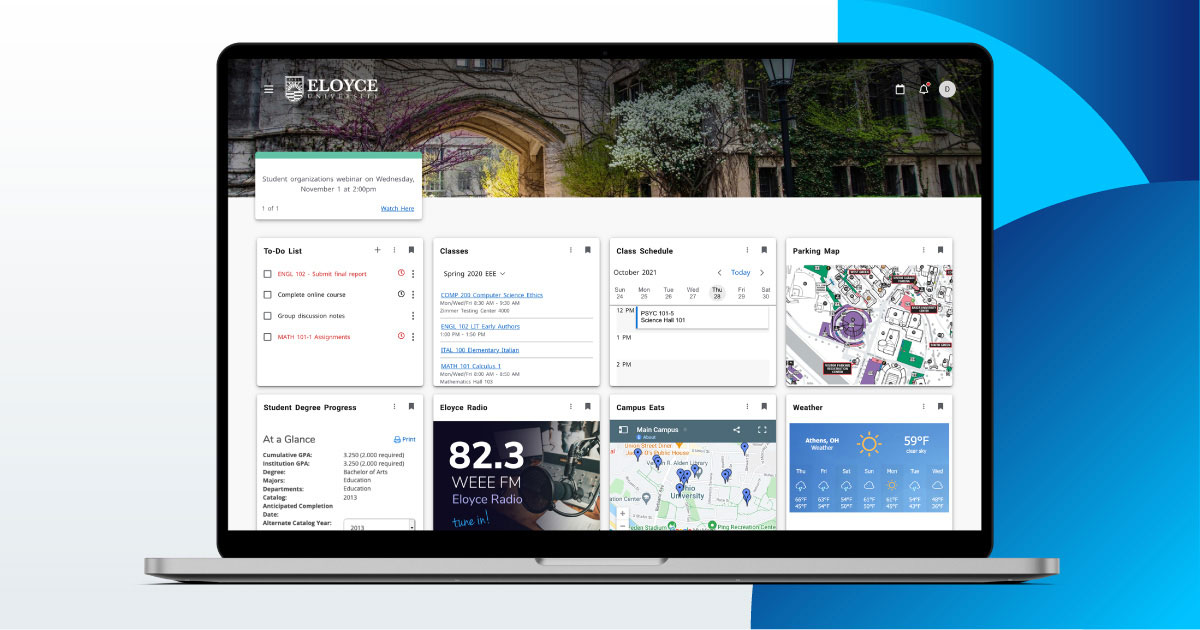McNeese State University (MSU) had a rough 2020. Based in Louisiana, MSU weathered back-to-back hurricanes, the crash of their outdated campus dashboard, and, well, the start of “unprecedented times.” Up against so many challenges, it may come as a surprise that replacing their old student information hub could rank as a priority. But amid crisis, implementing a centralized, single sign-on portal was a top concern for MSU, whose leaders recognized the importance of direct and streamlined communication under any circumstance.
Without a unified hub, the resulting volume of login screens and redirects makes it easy to miss key information required to take care of everyday tasks. For example, students may not see scholarship opportunities if financial aid is entirely separate from the payment center. Or, they might be checking their course portal for class cancellations, only to miss an email from their instructor. When information is partitioned across applications, users are left with too many tabs open, endless passwords to remember, and a lot of frustration.
A centralized, single sign-on portal or dashboard is a personalized destination in which students, faculty, and staff can both view and complete tasks in their daily schedule. Instead of making users track down services from one application to the next, a dashboard aggregates and delivers all the information they need, every step of the way. And as the higher education landscape continues to evolve, institutions will need to prioritize convenient and clear services to best support students.
Alleviating Information Overload
In a 2022 survey,* respondents identified feeling “overwhelmed by the amount of information” as the top challenge for students using education technology. When services are disconnected from each other or lack clear directions for use, students seeking information may give up before they find what they need. In some cases, this only results in a late assignment and a lower grade. Other times, in the worst-case scenario, being unable to find information means the difference between receiving financial aid or having to drop out. Missed deadlines, while often attributed to a student’s lack of organization, can be a product of increasing demands on users’ attention when the stakes aren’t always apparent. When institutions do a better job centralizing information and scheduling effective notifications, students are more likely to succeed.
*Results from a nationally representative sample of 999 students currently enrolled in a higher education program, conducted for Ellucian by Hanover Research in March 2022
Shifts in higher education to provide greater flexibility and credentialing options reflect how the “average student” has changed. Today, more people are taking classes while working and/or raising a family, which makes for a tricky and too-often unsustainable balancing act. In a 2021 survey cited by the Chronicle of Higher Education, among the respondents who had stopped pursuing higher education, more than half identified the cost of tuition as a primary barrier, more than a third cited family responsibilities, and a quarter work conflicts. When stacked against other priorities, education will too often land at the bottom of the list.
A campus portal can make the process of learning and staying enrolled intuitive enough to fit into an already busy life, but it’s not enough to build a dashboard and park it on a webpage. In addition to the need for services to be accessible remotely, the pandemic revealed the extent of the digital divide in higher education. While campuses have since resumed in-person classes, many students still lack consistent access to Wi-Fi-enabled devices besides their phones. Because of this, institutions must develop a portal that’s mobile-responsive and optimized for on-the-go use.
Meeting Users Where They Are
Mobile responsiveness isn’t just an important accessibility point. It’s an expectation. Today’s student is a consumer first and wants institutional functions to be available online, from any device, at any time. If you can order a pair of shoes from an app on your phone at 2:00 a.m., why can’t you check your financial aid status as easily? Or request a transcript? Or find answers to frequently asked questions?
While zoomers are typically the most digitally literate among the student body, all generations have been conditioned to grab their phones first when looking for answers. A centralized dashboard—particularly when delivered by a dedicated app—can bypass the wild goose chase of a Google search, saving time and resources while encouraging students to take an active, independent role in their education.
Self-service can’t, and shouldn’t, take the place of in-person support, but it is a useful, anytime-anywhere tool to help keep students on track. When integrated with a campus portal, self-service minimizes the number of emails, texts, phone calls, and office visits it takes to manage requirements, track degree progress, and perform other activities students need to stay enrolled.
Powering Modern Services with Data
The difference between an effective campus portal and a homepage with a bunch of hyperlinks is data. While a centralized access point provides students with a cohesive experience, the greater benefit is the integration of software and data across the wider campus technology ecosystem, driving collaborative efforts to ensure successful outcomes.
Advisors already have access to common performance indicators such as grades and attendance rates, which can provide an early warning if a student is struggling. But data can be used to support student well-being in a variety of ways, tracking everything from housing status to meal plan usage. An interoperable campus—in which information can be shared across systems and departments—can create early-alert systems that analyze student data and mobilize the right support exactly when it’s needed.
Early alerts are most effective when students, faculty, and staff are receiving them in the same digital environment, making it easier to loop in additional parties. Full interventions aren’t always required, however. Often, all that’s needed to keep relatively simple administrative tasks from derailing a student journey is a simple “nudge.” These short, automated reminders ensure every user knows exactly what’s needed from them without requiring faculty and staff to follow up with students manually.
How to Get Started with a Campus Portal
While the type of information delivered by a personalized campus portal or dashboard can be tailored to individual users, there are a few common areas of interest. In general, students should have easy access to the following:
- Overview of current and previous classes
- Assignments and current grades
- Financial aid status and outstanding documents
- Payment center
- Advisor details and contact information
- Degree progress
- Upcoming events
- Campus health resources
These are starting points, but users should be able to personalize their portals quickly, easily, and at any time. For example, at the beginning of the semester, a student may want class registration at the top of their dashboard, but after the add/drop period, current grades may get priority instead.
To make sure the campus portal is adequately serving its users, institutions should also gather feedback from students, faculty, and staff at a regular cadence. By incorporating the community’s perspective while communicating all relevant changes, campus leaders can guide users through the portal’s implementation and all future updates.
Modernizing the Campus Experience
Centralized, single sign-on campus portals are a key piece of the higher education modernization puzzle, giving students more agency, convenience, and clarity, while equipping faculty and staff to do their most impactful work. Self-service enables students to easily manage their own academic progress, while interoperable systems coordinate support from teachers and advisors whenever it’s needed. And by ensuring all services are connected and accessible anytime, from any device, institutions can remove roadblocks to success and help all members of the campus community stay focused on what’s most important.




